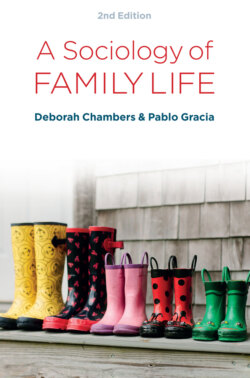Читать книгу A Sociology of Family Life - Deborah Chambers - Страница 14
Companionate marriage
ОглавлениеAlthough Parsons argued that the modern nuclear family had adapted its functions to support capitalism, this ideology generated anxiety among many sociologists. It was feared that the values of materialism and consumerism, associated with urban society, would contribute to a fragmentation of family life. Carle Zimmerman (1947) considered the urban American family of the 1940s and 1950s to be a disturbing sign of family disintegration. Zimmerman argued that the family could no longer adequately carry out vital functions such as reproduction and socialization, stating that ‘unless some unforeseen renaissance occurs, the family system will continue headlong its present trend towards nihilism’ (1947:808). Burgess and Locke (1945) claimed that the model of the American family was transforming from an institution to a relationship of companionship, in response to the disintegration of the traditional systems of control that had once stabilized the extended version of the family. Individuals expected more personal autonomy in their lives and fewer family restrictions. The loss of the economic function of families coincided with a stronger accent on the cultural purpose of families in fostering individual fulfilment. This shift was also linked with the resettlement from sociable rural communities to more anonymous urban and suburban settings.
Burgess (1973) argued that, together with the rise of outside influences such as the media and popular culture, widespread social changes were causing family instability. Women were targeted as particular problems to society. They were becoming more self-seeking and individualistic through a loosening of patriarchal ties that had traditionally bound them to their families. Women’s increasing independence endangered the permanence of the nuclear family, which was structured to address men’s, not women’s, personal needs. In response, the companionate marriage was an ideology deployed to defuse feminine individualism and evoke a new kind of egalitarian family (Cheale 2002; Finch and Summerfield 1991). The ideology of ‘companionship’ in marriage emerged, then, out of these concerns to forge an ideal of conjugal friendship. The aim was to protect the family against an invasion of selfish individualism. In the wake of traditional community decline and the rise of more alienated modes of urban living, the companionate marriage was treated as a kind of insurance: a necessary constituent of married life that glued heterosexual couples together.
This conjugal friendship marriage promoted the idea of an exclusive relationship that was to be mutually satisfying at an emotional and physical level for both partners. It evoked an egalitarian rapport between the spouses. Yet this egalitarian ideal was bolted on to a traditional patriarchal model of the family, defined by a male head of household as the ‘breadwinner’ with a dependent female homemaker. Paradoxically, this ideal was evoked in societies where women could not vote and had restricted access to both education and employment (Smart 2007). The apparently incompatible features of patriarchal power and control were combined with private, sexual and emotional dimensions of conjugal relationships. Public acceptance of the companionate marriage fostered the idea of a separation of reproduction from sexual pleasure. This elevation of sexual pleasure signified a fundamental shift in thinking because it promoted the belief that marriage was not simply a means to having children, even though this was still perceived as a key function of ‘the family’. As David Cheale (1999) argues, the companionate marriage was an antidote to the encroaching values of individualism, but married couples could only make this transition with the help of experts. An army of family experts, such as sexologists, child guidance clinics, marriage counselling centres, psychiatrists and clinical psychologists were at hand to sort out the emotional problems of children and adults.
